Music Educators Association of New Jersey
Serving teachers and students since 1927



Magdalena Stern-Baczewska's first declaration was that she hopes her lecture/demonstration of early keyboard music on May 17 will help to bring it alive for us and for our students.
SPAIN: First she played a guitar piece, followed by a harpsichord recording of the same piece showing the evolution of Spanish harpsichord music replicating the plucking sound associated with guitar.
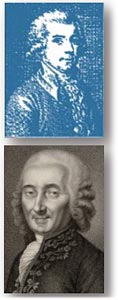
 Antonio Soler was a Catalan composer who took holy orders and composed 150 keyboard sonatas. Magdalena played a recording of Scott Ross performing Soler's most famous, tranceinducing piece Fandango. She called attention to the bass line, which could be either in duple or triple meter, and to Flamenco-like small variations, similar to improvisations, on six left hand notes. In a second recording, a tremolo is applied to the interval of a third. In a different tempo, the performer has the freedom to contribute variety by adding notes and ornaments not written in the score. The written music provides a skeleton for the interpreter to expand on.
Antonio Soler was a Catalan composer who took holy orders and composed 150 keyboard sonatas. Magdalena played a recording of Scott Ross performing Soler's most famous, tranceinducing piece Fandango. She called attention to the bass line, which could be either in duple or triple meter, and to Flamenco-like small variations, similar to improvisations, on six left hand notes. In a second recording, a tremolo is applied to the interval of a third. In a different tempo, the performer has the freedom to contribute variety by adding notes and ornaments not written in the score. The written music provides a skeleton for the interpreter to expand on.
Luigi Boccherini moved at age 18 from Italy to Madrid. His style, born out of travel between countries, resulted in a string quartet and guitar piece and an arrangement thereof for two harpsichords with parts that sound like a dancer clicking castanets. A Soler sonata, another mixture of Spanish and Italian influences in binary form with irregular phrase lengths and "copy and paste repetitions," could be confused with Scarlatti. Magdalena played Scarlatti's K.380 Sonata in E major.
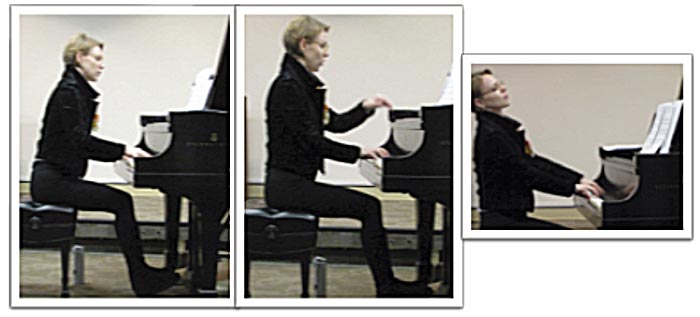
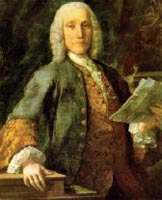 ITALY: Domenico Scarlatti was employed by the Queen of Poland and moved with the queen to Italy. As Magdalena put it, she was "the first Polish queen exiled in Rome.” Scarlatti was choirmaster at St. Peter's (the Vatican) for several years, then became court harpsichordist to the King of Portugal and teacher of Princess Maria Barbara in Lisbon. He accompanied Maria Barbara to Madrid on her marriage to the Spanish Crown Prince. Scarlatti lived in Seville, the home of flamenco, and married a Spanish woman.
ITALY: Domenico Scarlatti was employed by the Queen of Poland and moved with the queen to Italy. As Magdalena put it, she was "the first Polish queen exiled in Rome.” Scarlatti was choirmaster at St. Peter's (the Vatican) for several years, then became court harpsichordist to the King of Portugal and teacher of Princess Maria Barbara in Lisbon. He accompanied Maria Barbara to Madrid on her marriage to the Spanish Crown Prince. Scarlatti lived in Seville, the home of flamenco, and married a Spanish woman.
Ralph Kirkpatrick catalogued Scarlatti's works. He described Scarlatti's works as courtly and savage; full of gaiety with an undertone of tragedy; reflecting Spanish life, including castanets and the wailing lament of a gypsy singer. The performer will add a fourth to a chord to emphasize dissonances. Magdalena played K.109, a fandango in two or three - 6/8 as opposed to 3/4. The bass line switches accents from four to three. One could add a little "strum" (rolled chord) to the left hand instead of a single held note. The ringing of a left hand rolled chord added dissonance. One could "trill on a main note...unless you don't want to." Magdalena played a recording of Scott Ross performing K. 492 Sonata in D major. His articulation is incredibly guitar-like on the harpsichord. It has savage beauty; urban toughness comes through. Magdalena suggests: go beyond beautiful phrasing; tap into something wild. It makes the music more alive. Scott Ross accents the end of phrases, as one would not normally do. It almost sounds ugly at the beginning. The music just flows; both voices trilling suggest North African singing. Because there is no dynamic variety to the harpsichord, these techniques add spice to the music.
On the other hand, the E minor Sonata, K.87 is in the style favored at the Vatican. As the son of Alessandro Scarlatti, Domenico heard sacred organ music with Palestrina-like counterpoint. In the E minor Sonata one can almost hear the Latin text, imitation in voices, melisma. K.208 Sonata in A major is the only piece Scarlatti directs should be played "cantabile." Scarlatti was a friend of castrato Cantelli (a countertenor). Castrati were known for being able to hold a note a long time. This sonata sounds slow, in Italian style; long-winded. This piece is proof against the thesis that there is no emotion in Baroque music. It is similar in mood to the second movement of J.S. Bach's Italian Concerto and, as someone in the audience pointed out, to Bach's Adagio transcription of the D minor Oboe Concerto by Alessandro Marcello, heard as piano music in the movie 50 Shades of Grey.
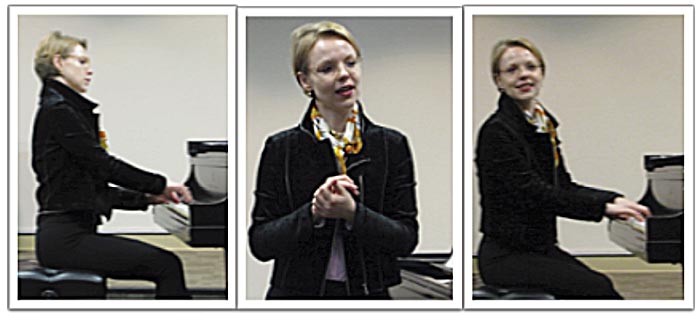
 GERMANY: The German Johann Froberger traveled to Italy, where he studied with Girolamo Frescobaldi and writes resolving dissonances. Froberger's 1660 Meditation on my Future Death, a sarabande from Suite 20 with two repeated sections of irregular lengths, was played in meantone tuning in which 3rds are in tune, but 5ths are not. Written in duple meter, it was up to the performer to make decisions about adding ornaments or short figures or quick runs. It was Froberger who established the order of the core dances in the suite: allemande, courante, sarabande and gigue, although he often left out the gigue. Bach was inspired by Frescobaldi's Toccata in G from the second Book of Toccatas. It is composed in sections; look for cadences and then change tempos at will. In reference to notation, the G minor chord is written, but each time one improvises on it. Harpsichordists did not play with thumbs, but with paired fingering: 2+3 and 3+4. So Frescobaldi contributed meantone tuning, paired fingering, and interpretation freedom. It was Bach and Rameau who began changing the fingering by adding thumbs. However, in Bach's book dedicated to Wilhelm Friedemann, Bach recommends starting on the strong finger, 2 or 3 to produce an effect similar to bowing. In cadenza passages, due to narrower harpsichord keys, most performers use the thumb in declamatory style in a period way.
GERMANY: The German Johann Froberger traveled to Italy, where he studied with Girolamo Frescobaldi and writes resolving dissonances. Froberger's 1660 Meditation on my Future Death, a sarabande from Suite 20 with two repeated sections of irregular lengths, was played in meantone tuning in which 3rds are in tune, but 5ths are not. Written in duple meter, it was up to the performer to make decisions about adding ornaments or short figures or quick runs. It was Froberger who established the order of the core dances in the suite: allemande, courante, sarabande and gigue, although he often left out the gigue. Bach was inspired by Frescobaldi's Toccata in G from the second Book of Toccatas. It is composed in sections; look for cadences and then change tempos at will. In reference to notation, the G minor chord is written, but each time one improvises on it. Harpsichordists did not play with thumbs, but with paired fingering: 2+3 and 3+4. So Frescobaldi contributed meantone tuning, paired fingering, and interpretation freedom. It was Bach and Rameau who began changing the fingering by adding thumbs. However, in Bach's book dedicated to Wilhelm Friedemann, Bach recommends starting on the strong finger, 2 or 3 to produce an effect similar to bowing. In cadenza passages, due to narrower harpsichord keys, most performers use the thumb in declamatory style in a period way.
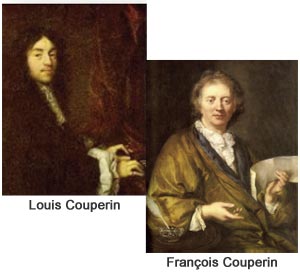 FRANCE: In France, Louis Couperin and his nephew François were writing "unmeasured preludes." There is no meter indicated, but slurs guide you through chord progressions. Do not add any notes. The performer comes up with the shape of the piece. François composed a suite of twenty dances with programmatic titles. All ornamentation is indicated with squiggles. Both Couperins are accused of controlling their music by over-dotting, in French Overture style. (Bach double-dotted his French Overture.) Rameau wrote an A minor suite also unmeasured. Rameau programmatic titles include Chopped Bacon and The Limping One, two pieces demonstrated by Magdalena. A Couperin sarabande titled The Majestic One is fast and never stops rolling; it flows sensuously. Whereas most suite dances were pair dances, the sarabande was a solo dance.
FRANCE: In France, Louis Couperin and his nephew François were writing "unmeasured preludes." There is no meter indicated, but slurs guide you through chord progressions. Do not add any notes. The performer comes up with the shape of the piece. François composed a suite of twenty dances with programmatic titles. All ornamentation is indicated with squiggles. Both Couperins are accused of controlling their music by over-dotting, in French Overture style. (Bach double-dotted his French Overture.) Rameau wrote an A minor suite also unmeasured. Rameau programmatic titles include Chopped Bacon and The Limping One, two pieces demonstrated by Magdalena. A Couperin sarabande titled The Majestic One is fast and never stops rolling; it flows sensuously. Whereas most suite dances were pair dances, the sarabande was a solo dance.
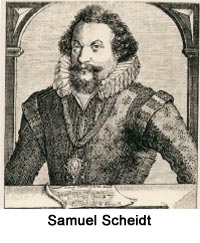
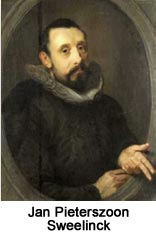 In Germany, we find a combination of Italian and French styles. Samuel Scheidt, born in 1587 and whose works are included in Jewish musical programs today, introduced "Fantastic style" - a multi-sectional style à la Frescobaldi. Scheidt's 49 Preludes for Organ became the "Bible" for organists of the time and influenced Bach's organ works. Scheidt went to Amsterdam to study with Sweelinck, who was known as "The Orpheus of Amsterdam." Sweelinck is credited with composing the earliest fugues in his fantasias, a completely free form encouraging counterpoint on the spot. Sweelinck's Fantasy Chromatica is in the Dorian mode. There were different ways of tuning the harpsichord in a German town versus tuning in an Italian town.
In Germany, we find a combination of Italian and French styles. Samuel Scheidt, born in 1587 and whose works are included in Jewish musical programs today, introduced "Fantastic style" - a multi-sectional style à la Frescobaldi. Scheidt's 49 Preludes for Organ became the "Bible" for organists of the time and influenced Bach's organ works. Scheidt went to Amsterdam to study with Sweelinck, who was known as "The Orpheus of Amsterdam." Sweelinck is credited with composing the earliest fugues in his fantasias, a completely free form encouraging counterpoint on the spot. Sweelinck's Fantasy Chromatica is in the Dorian mode. There were different ways of tuning the harpsichord in a German town versus tuning in an Italian town.
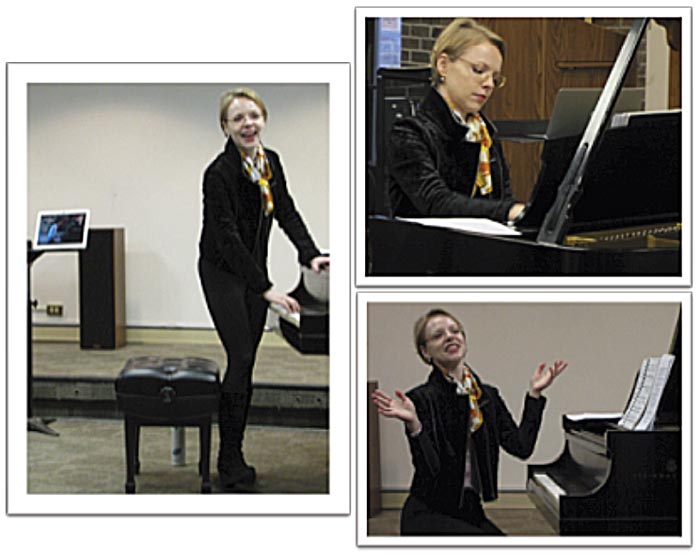
In conclusion, Ms. Baczewska declared that Baroque music, including Bach, is alive and well. "There is so much freedom in music that lives and breathes." We were thrilled by Magdalena's Baroque period piano playing and by recordings she shared with us. She gave us so much information that it was difficult to capture it all in print. We look forward to her return to the MEA!
Beverly Shea, writer
Nancy Modell, photos and page design
Ruth Kotik, Hostess